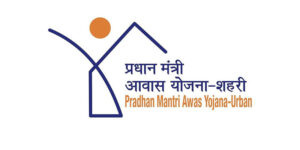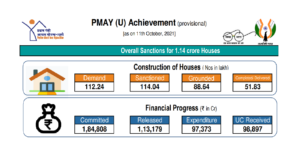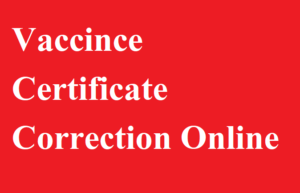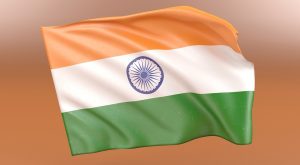Pradhan Mantri Awas Yojana, PMAY New List, How To Search Your Name
Pradhan Mantri Awas Yojana – Urban (PMAY-U), a flagship Mission of Government of India being implemented by Ministry of Housing and Urban Affairs (MoHUA), was launched on 25th June 2015. The Mission addresses urban housing shortage among the EWS/LIG and MIG categories including the slum dwellers by ensuring a pucca house to all eligible urban households by the year 2022, when Nation completes 75 years of its Independence.
Pradhan Mantri Awas Yojana (Urban)-PMAY (U)

PMAY (Urban) – Progress
| Houses Sanctioned | 114.04 Lakhs |
| Houses Grounded | 88.64 Lakhs |
| Houses Completed | 51.83 Lakhs |
| Central Assistance Committed | 1.85 Lakh Cr. |
| Central Assistance Released | 113179 Cr. |
| Total Investment | 7.52 Lakh Cr. |
Pradhan Mantri Awas Yojana List 2021

How To Search Name in PMAY New List
- Go To The Official Website Of The Government https://pmaymis.gov.in/#.
- Click On Search Beneficiary.
- Click On Search By Name.
- Your Name with The Application Status will be Appear on Your Screen.
Eligibility For PMAY
A person will be Eligible according to the Following Conditions –
- Age Of The Person Must Lies Between 21 Years to 55 Years.
- Person Should Not Have The House Before.
- Person Must Not Be The Beneficiary Of This Scheme Before Applying For The Scheme.
- Person Should Have AADHAR Card.
Documents For PMAY
Person Who Wants to be Beneficiary Of this Scheme, Must Have –
- A Photo Copy Of Bank Account Passbook.
- Mobile Number.
- Photos
- Salary Certificate
- A Complete Address Of The House.
- AADHAR Card.
- Voter’s ID Card.
- Ration Card.
Frequently Asked Questions About PMAY
1. What is Pradhan Mantri Awas Yojana (Urban) and its objectives and scope?
Pradhan Mantri Awas Yojana (Urban) for ensuring housing for all in urban areas was launched on 25th June 2015 providing pucca houses to all eligible beneficiaries by 2022. The Mission provides Central Assistance to implementing agencies through States/Union Territories (UTs) and Central Nodal Agencies (CNAs) for providing houses to all eligible families/ beneficiaries against the validated demand for houses for about 1.12 cr.
PMAY(U) has made a mandatory provision for the female head of the family to be the owner or co-owner of the house under this Mission. A basket of options is adopted to ensure more number of people depending on their income, finance and availability of land through following four options.
1. “In-situ” Slum Redevelopment (ISSR)
2. Credit Linked Subsidy Scheme (CLSS)
3. Affordable Housing in Partnership (AHP)
4. Beneficiary-led individual house construction/enhancements (BLC)
2. What is In-Situ Slum Redevelopment?
Under Slum redevelopment Central Assistance of Rs.1 lakh per house is admissible for all houses built for eligible slum dwellers under the component of In-situ Slum Redevelopment (ISSR) using land as Resource with participation of private developers.
This slum rehabilitation grants can be utilised by States/UTs for any of the slum redevelopment projects. After redevelopment, de-notification of slums by State/UT Government is recommended under the Mission guidelines.
3. What is Credit Linked Subsidy Scheme (CLSS)?
Interest Subsidy up to 2.67 lakh per house is admissible for Beneficiaries of Economically Weaker Section (EWS)/Low Income Group (LIG), Middle Income Group (MIG)-I and Middle Income Group (MIG)-II seeking housing loans from Banks, Housing Finance Companies and other such institutions for acquiring/constructing houses.
4. What is Affordable Housing in Partnership (AHP)?
5. What is Beneficiary led individual house construction enhancements (BLC)?
Under this component, Central Assistance of Rs.1.5 lakh is available to individual eligible families belonging to EWS categories to either construct new houses or enhance existing houses on their own to cover the beneficiaries who are not able to take advantage of any other component of the Mission.
If the beneficiary has a pucca house with carpet area of up to 21 sq. mt. area or a semi-pucca house, lacking in one of the facilities- i.e. room, kitchen, toilet, bath or a combination of these, it may be taken up for enhancement subject to ULB/State ensuring structural safety of the house and adherence to following conditions:
• The total carpet area after enhancement must not be less than 21 sq. mt and must not be more than 30 sq. mt.
• Enhancement shall mean addition of minimum carpet area of 9.0 square meters in to the existing house with pucca construction of at least one habitable room or room with kitchen and/or bathroom and/or toilet conforming to NBC norms.
6. Who is defined as a beneficiary under Pradhan Mantri Awas Yojana (Urban) Scheme?
- A beneficiary is defined as a family comprising of husband, wife and unmarried children. Such beneficiary should not own a pucca house either in his / her name or in the name of any member of his / her family in any part of India to receive Central Assistance under the Mission.
- Person having pucca house less than 21 sqm may be included under enhancement of existing house
- Adult earning member irrespective of marital status are also eligible.
- EWS category of beneficiaries is eligible for Assistance in all four verticals of the Missions whereas LIG/MIG category is eligible under only CLSS component of the Mission.
7. Who are the nodal agencies who will be operating or responsible for disbursal of the subsidy under Credit Linked Subsidy Scheme (CLSS)?
NHB, HUDCO and SBI have been identified as Central Nodal Agencies (CNAs) to channelize this subsidy to the lending institutions and for monitoring the progress of this component. Ministry may notify other Institutions as CNA in future.
8. Any preferential treatment to beneficiaries proposed for Affordable Housing?
Preference under the Scheme will be given to Manual Scavengers, Women (with overriding preference to widows), persons belonging to Scheduled Castes/ Scheduled Tribes/ Other Backward Classes, Minorities, Persons with disabilities and Transgenders subject to beneficiaries being from EWS / LIG segments.
9. What happens where a beneficiary having availed housing loans from one of the PLIs and also benefit under CLSS switches over to another PLI for taking advantage of the reduced interest rate?
A beneficiary who has taken a housing loan and availed of interest subvention under the scheme but later on switches to another PLI for balance transfer will not be eligible or claim the benefit of interest subvention again. Beneficiary can claim interest linked subsidy on only one loan account.
10. What happens when the subsidy has already been disbursed but due to certain reasons the construction of the house is stalled?
In such cases, the subsidy is to be recovered and refunded to the Central Government.
11. Can we get 30 year home loan for EWS beneficiary?
Yes, beneficiaries can apply for sanction of home loan for tenure of 30 years, which would depend on the due diligence norms of the PLIs concerned. In such cases, however, the interest subsidy would be restricted on home loans up to Rs. 6 lakhs for tenure not more than 20 years.
12. What is criteria for EWS LIG MIG categories for the purpose of the Scheme
The EWS/LIG/MIG categories are defined as follows:
- EWS households with an annual income up to Rs. 3.00 lakhs.
- LIG households with an annual income between Rs. 3.00 lakhs to Rs. 6.00 lakhs.
- MIG-I households with an annual income between Rs. 6.00 lakhs to Rs. 12.00 lakhs.
- MIG-II households with an annual income between Rs. 12.00 lakhs to Rs. 18.00 lakhs. States/UTs have flexibility to redefine the annual income criteria as per local needs with the approval of Ministry.
13. Whether a beneficiary can avail of benefit under more than one component?
No. Under the Mission, a beneficiary can avail of benefit of one component only.
14. Are there any area restrictions under the Scheme for availing of the subsidy under the CLSS component?
The carpet area of houses being constructed under this component should be as follows:
- Up to 30 sq.m. for EWS category
- Up to 60 sq.m. for LIG category
- Up to 160 sq.m. for MIG-I category
- Up to 200 sq.m for MIG-II category
This means that if the carpet area exceeds the respective limits, then the beneficiaries would not be eligible to avail of the benefit under this component.
15. What is the definition of carpet area?
Area enclosed within the walls, actual area to lay the carpet. This area does not include the thickness of the inner walls.
16. Who are Primary Lending Institutions (PLIs)?
Primary Lending Institutions are Scheduled Commercial Banks, Housing Finance Companies, Regional Rural Banks (RRBs), State Cooperative Banks, Urban Cooperative Banks or any other institutions as may be identified by the MoHUA.
17. Will a person having a plot without any construction be an eligible beneficiary?
Yes, beneficiary can be covered under subsidy for beneficiary led individual house construction scheme, if otherwise eligible.
18. How the Central Assistance will be released to beneficiaries for individual house construction?
Central Assistance will be released to the bank accounts of beneficiaries identified in projects through States/UTs as per recommendations of State/UT.
19. How the subsidy is to be released to beneficiaries?
The subsidy would be released by the CNAs based on the disbursements made by PLIs to the beneficiaries. Subsidy, so disbursed by the CNA to the PLI, will be credited by the PLI to the borrower’s account upfront by deducting it from the principal loan amount.
As a result, the borrower will pay EMI on the remainder of the principal loan amount. E.g., the borrower avails a loan for Rs. 6.00 lakhs and subsidy thereon works out to Rs. 2.20 lakhs, the amount (Rs. 2.20 lakhs) would be reduced upfront from the loan (i.e., the loan would reduce to Rs. 3.80 lakhs) and the borrower would pay EMIs on the reduced amount of Rs. 3.80 lakhs.
For More Updates About The Government Schemes, Visit www.saconindia.org




